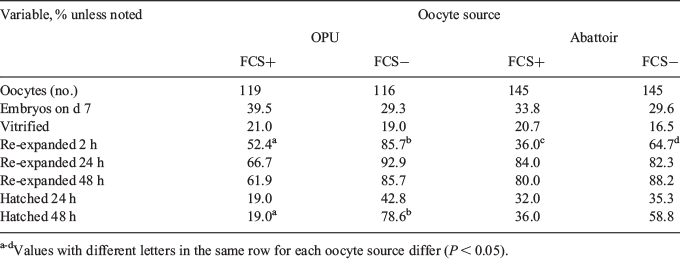31 Effect of fetal calf serum on production and cryotolerance of in vitro bovine embryos from Ecuadorian Creole heifers
M. S. Méndez A , M. E. Soria A , L. R. Galarza A , F. P. Perea A B and D. E. Argudo AA Laboratorio de Biotecnología de la Reproducción Animal, Universidad de Cuenca, Cuenca, Ecuador;
B Departamento de Ciencias Agrarias, Universidad de Los Andes, Trujillo, Venezuela
Reproduction, Fertility and Development 31(1) 141-142 https://doi.org/10.1071/RDv31n1Ab31
Published online: 3 December 2018
Abstract
In the Ecuadorian Andes there is a Creole bovine biotype whose population is disappearing. In vitro embryo production and cryopreservation is an important biotechnology that allows the conservation of animals threatened with extinction. The objective of this study was to determine the in vitro production and cryopreservation of embryos from creole heifers raised in the highlands of Ecuador. Immature cumulus-oocyte complexes were retrieved by ovum pickup from 10 Creole heifers (OPU) and from abattoir ovaries (control). The experiment was completed within 8 replicates. Cumulus-oocyte complexes were cultured in a maturation medium (TCM-199 supplemented with 10% fetal bovine serum, 100 µg mL−1 of sodium pyruvate, 0.75 mg mL−1 of l-glutamine, 4 µg mL−1 of FSH-p, 100 µM cysteamine, and 250 µg mL−1 of gentamicin) following IVF (SOF medium supplemented with 10 µg mL−1 heparin) and in vitro culture (citrate SOF medium). After denudation (Day 1 after IVF), presumptive embryos from each oocyte source (OPU and control) were split into 2 groups: with (FCS+) and without (FCS−) FCS (2.5%), which was added on Day 5 after IVF. On Day 7, embryos were evaluated, and those with quality 1 were vitrified. After warming, embryo re-expansion at 2 h and embryo re-expansion and hatching at 24 and 48 h were evaluated. Data were analysed by logistic regression in SAS software (SAS Institute Inc., Cary, NC, USA). Results of embryo rate at Day 7 and rates of vitrified, re-expanded, and hatched embryos are shown in Table 1. Regardless of the oocyte source, the addition of 2.5% FCS decreased embryo re-expansion at 2 h and reduced embryo hatching at 48 h in the OPU group. In conclusion, FCS did not improve embryo production and adversely affected the cryotolerance of embryos produced in vitro from Ecuadorian creole heifers.

|


